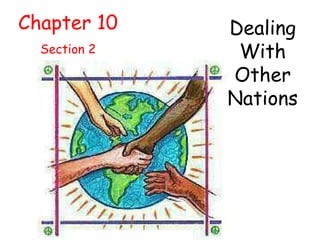
Section 2 Notes
- 1. Chapter 10 Section 2 Dealing With Other Nations
- 2. Why do I have a picture such as this representing section 2 of chapter 10? Other nations kept picking fights with us.
- 3. As a newcomer to world politics, the U.S. in the 1790’s was weak compared with the powerful European nations- Great Britain, France, and Spain.
- 5. The U.S. had only a small army and no navy. It was not militarily strong enough to get involved in conflicts with other nations. Does anyone know the name of this famous navy ship?
- 6. The Treaty of Paris in 1783 was supposed to settle arguments about the land west of the Appalachian Mountains. On paper this land belonged to the U.S. but the British continued to occupy forts in the area.
- 7. Challenges From Other Nations A. Despite Britain’s pledge as part of the Treaty of Paris to leave North America, the British still occupied forts in the Ohio Valley and Great Lakes region in the 1790’s. B. The British befriended and supported the region’s Native Americans who often fought with colonial settlers. C. In 1794, colonial troops defeated a group of Native Americans at the Battle of Fallen Timbers in present-day Ohio. As a result, Native American resistance in the Ohio Valley all but disappeared. In the Treaty of Greenville Native Americans agreed to surrender land in Ohio. D. Spain, which held the Louisiana Territory, also made trouble for Western settlers who used the Mississippi River for trade. Meanwhile, pirates from North Africa, the Barbary Pirates , harassed American trade ships in the Mediterranean Sea .
- 9. Barbary Pirates harassed the U.S. by stealing cargoes, seizing American ships, and imprisoning American sailors. The Pirates knew they could get away with it because the U.S. had no navy. To sail safely, the U.S. had to pay tribute , or protection money, to local rulers.
- 10. Why might foreign countries have had little hesitation in harassing the United States during this period ? The U.S. was a new and untested nation and thus did not pose a threat.
- 11. Where are we and what does this place have to do with America in 1789?
- 12. In 1789 many French people rebelled against the high taxes and oppressive rule of the monarchy and set up a republic. Over several years of bloody fighting, the king and queen of France and many aristocrats were arrested and beheaded on the guillotine.
- 14. II. Choosing Neutrality A. In 1793, Great Britain and other nations declared war on France’s revolutionary government. The United States took a position of neutrality in the matter. However, Edmond Genet , a French diplomat, put American neutrality to the test. B. Both Great Britain and France ignored America’s neutrality and seized hundreds of American ships. The British also impressed , or kidnapped, American sailors to serve in the British navy.
- 17. Why is this area so important for shipping?
- 19. Who am I and how did I differ from all other Presidents?